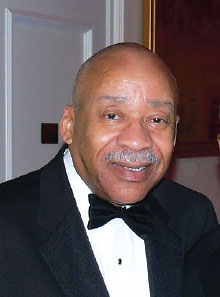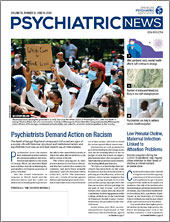Even in the more open 21st century, to be Black and gay is to carry a “double stigma” of racism and anti-gay bias, said psychiatrist Billy Jones, M.D., M.S., at the virtual APA Spring Highlights Meeting in April.
Jones was the recipient of this year’s John Fryer Award. This award is given each year to an individual whose work has contributed to the improvement of mental health of sexual minority communities. Jones is a clinical professor of psychiatry at NYU Langone Health; he is the former president/CEO of the New York City Health and Hospitals Corporation and former commissioner of the New York City Department of Mental Health.
Jones presented a comprehensive overview of the history of homosexuality within the African American community—including evidence of normative homosexual culture in Africa prior to the North American slave trade, sexual (including homosexual) exploitation of Black slaves during the “middle passage” to North America and during the period of enslavement, the emergence of gay culture within Black communities during Reconstruction and into the 20th century, and the history of Black people during the modern gay rights movement.
Jones concluded with a reassessment of the popular notion that the African American community—especially the Black church—is anti-gay, asserting that the current and historical reality suggests a far more nuanced picture.
In his examination of homosexuality in pre-slavery Africa, Jones drew on a 1998 book edited by Stephen Murray and Will Roscoe titled Boy Wives and Female Husbands: Studies in African Homosexuality. That text debunked a myth that homosexuality was nonexistent in Africa until it was introduced by colonization, Jones said.
“They point out that same-sex behavior has always been present all over sub-Sahara Africa in various forms and manifestations that are or were akin to the customs and culture of the tribes and/or regions.” Other historical sources also support the historical evidence of homosexuality in the Horn of Africa, Sudan, and East Africa, Jones said.
Little is written or found about Black male homosexuality during slavery, Jones said. But he added, “It is simply unimaginable that there was little or no male same-sex behavior.”
Jones said the often brutal treatment of slaves included sexual exploitation and must have also involved homosexual exploitation. Undoubtedly, there were homosexual bonds between some slave holders and slaves, and while slave holders might have considered a relationship to be mutual, enslaved men “were in no position to resist or refuse.”
He added, “In addition, the shame associated with the historical legacy of interracial male rape combined with stigma against homosexuality served to silence many occurrences.”
In the period after the end of slavery extending into the 20th century, a gay culture began to emerge among African American communities in the South. An article in The Nation this year recounted the history of William Swann, who was born a slave in Maryland and became known in the 1880s as the first gay “drag queen.”
The 2008 book Sweet Tea: Black Gay Men of the South, by E. Patrick Johnson, records interviews with gay Black men, aged 19 to 93 years old in 15 Southern states. Jones noted that the interviews speak to the contradictory nature of growing up gay in the Southern Black church.
He quoted Johnson who wrote that “despite the church’s homophobia, it is a place of comfort, a place where they were raised and first accepted, where they first felt a sense of community and belonging.”
Jones added, “Most of the narrators went through the struggle of sorting out this contradiction for themselves. Some have remained in these churches, some have maintained their spirituality and moved to ‘open and affirming’ religious communities, and others have moved away from organized religion.”
Jones noted that in the 20th century many of the talented artists, writers, musicians, and thinkers who emerged during the “Harlem Renaissance” were gay, and some were open about their homosexuality. Also, important figures in the civil rights movement—especially Bayard Rustin (an aide to the Rev. Martin Luther King Jr.) and the writer James Baldwin—were openly gay.
It was during the presidential campaign earlier this year of the openly gay candidate Pete Buttigieg, former mayor of South Bend, Ind., that the public and political commentators focused on the allegedly anti-gay bias among African Americans. Buttigieg had received criticism from Black leaders (and others) for problems in South Bend involving relations between police and African Americans in the city and for what some regarded as the candidate’s inattentiveness to Black concerns.
Jones said several prominent Black spokespeople—including the Rev. Al Sharpton and Jonathan Capehart, a gay Black columnist for the Washington Post—pushed back against the notion that the criticism was rooted in anti-gay bias.
“Black voters don’t own homophobia, and they are not monolithic,” Capehart wrote. “If candidates want their votes, they have to work for them continually and ask for them with sincerity. And if a candidate fails to win over African Americans, the fault is not those voters’. It’s the messenger and their message.”
Jones concluded by citing Marjorie Hill, Ph.D., who spoke at APA’s 2012 Annual Meeting about a paper she had written in the Journal of Gay and Lesbian Mental Health titled “Is the Black Community More Homophobic?”
Quoting Hill, Jones said, “What does exist is a multifaceted cultural web of psychosocial, historical, and contextual factors that camouflage how Black LGBT people are viewed from within their communities of origin. Unquestionably, there is overwhelming evidence of tolerance and acceptance of Black LGBT people within the Black community.” ■
“Jones’ presentation, along with slides, is archived on the APA website along with other Spring Highlights presentations
here.

